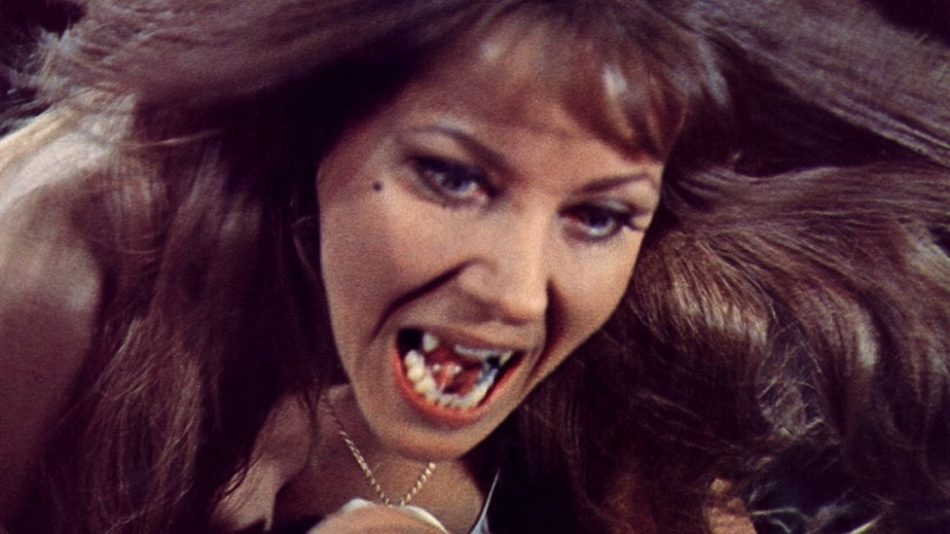
Welcome to the seventh instalment of “Virgin’s View” where I review a classic vampire film without being exposed to any background information or reviews, hence the term “virgin.” Beware spoilers ahead!
Plot
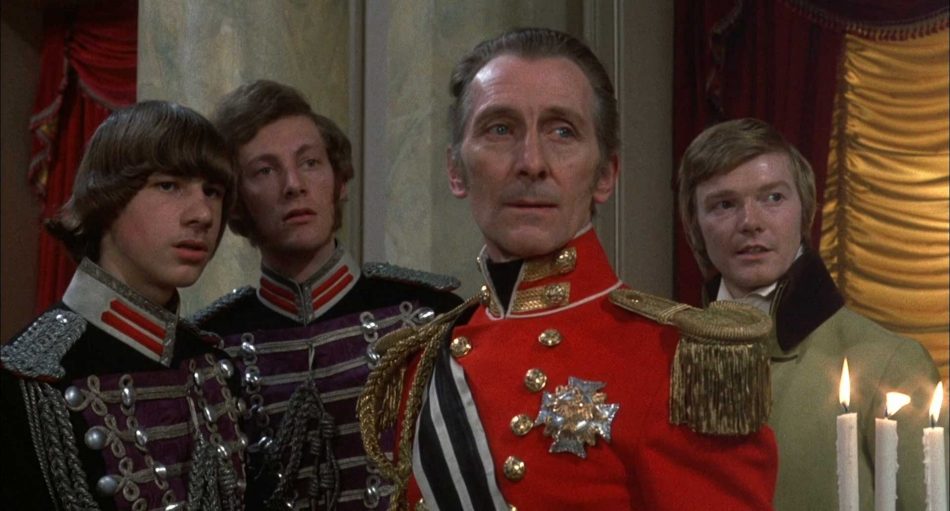
The Vampire Lovers (1970), A Hammer/American International Production, was directed by Roy Ward Baker. The film starred Ingrid Pitt, George Cole, Kate O’Mara, and Peter Cushing. When I saw Peter Cushing’s name in the beginning credits, I instantly thought back to one of my previous reviews, Horror of Dracula, where Cushing sported some rather fancy outfits.
We are introduced to Baron Hartog (Douglas Wilmer), a Three Musketeer groupie look-alike complete with his own sword.
Hartog was on a mission to avenge his sister’s death. He had the balls to steal a vampire’s shroud, which is needed to return to the grave and lured the vampire into a trap by waving it from the castle window.
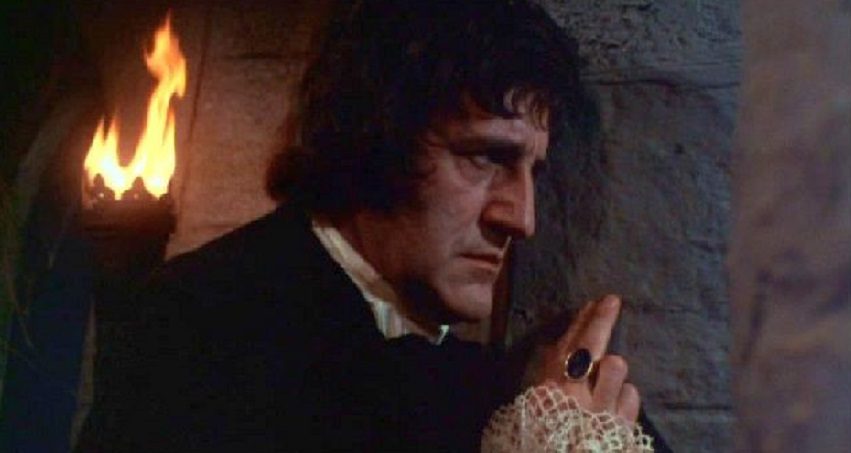
The well endowed femme fatale took the bait. She attempted to seduce Hartog and instead burnt her boobs on his cross right before being decapitated.
Fast forward to a party with aristocrats dancing in elegant ballgowns, servants wearing powdered wigs, and guests arriving in horse drawn chariots. I half expected Cinderella to make an appearance.
The host of the evening, the General (Peter Cushing), welcomed the Countess (Dawn Addams) and her beautifully voluptuous daughter Marcilla (Ingrid Pitt). The women’s foreign accents made me think they were vampires, but would have to wait till later to find out.
Marcilla stood out of the crowd being the only woman in red and had no problem finding a dance partner. The next dance was interrupted by the grand entrance of a vampire version of Mr. Bean (John Forbes-Robertson) wearing a flowing red cape as he waved around his fancy walking stick.
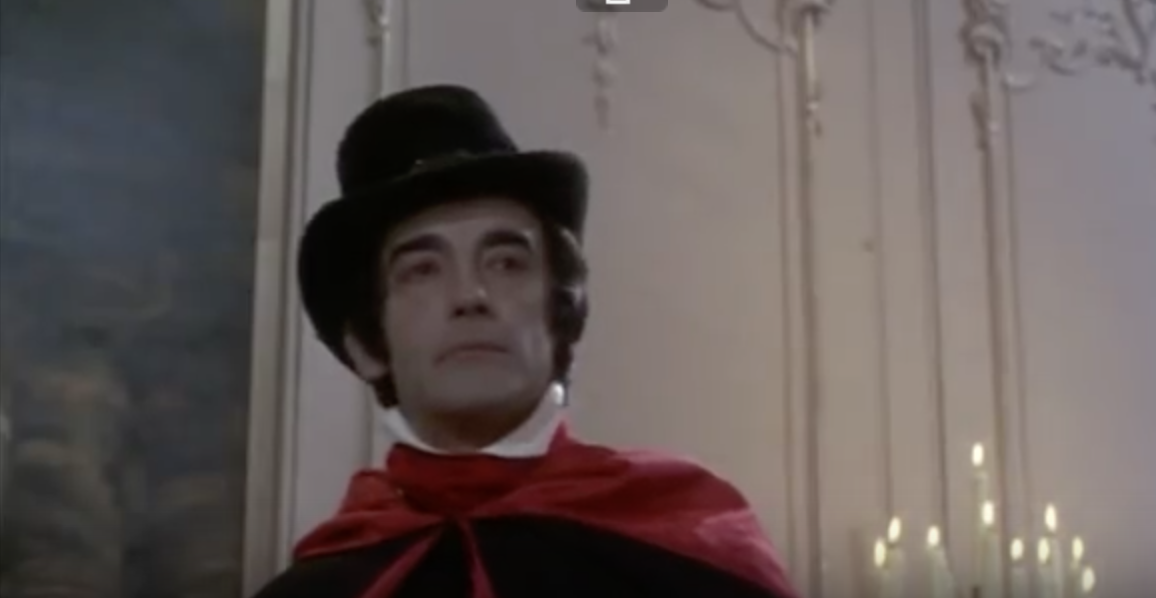
He briefly speaks with the Countess and quickly takes his leave. She goes straight to the General and makes arrangements for her daughter to board with the family for a short while.
The General’s daughter, Laura (Pippa Steele), and Marcilla quickly become BFFs. Meanwhile Marcilla has that whole creepy Fatal Attraction (1987) vibe going on when she declares her love for Laura. She also disappears and reappears randomly like a ghost.
Coincidentally, Laura is having crazy nightmares where a huge cat chokes her each night. She falls ill and dies a few days later. They suspect anemia until the body is examined and to no one’s surprised, discover two puncture marks on her breast.
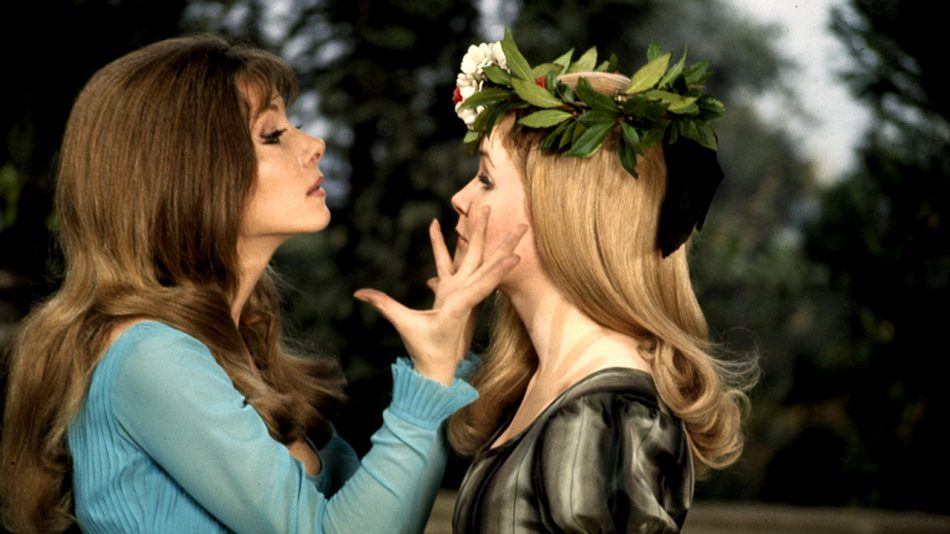
The General goes on a rampage continuously yelling Marcilla’s name. She is nowhere to be found, and the scene ends with a gravestone sporting her name and her ghostly figure disappearing into the night.
But this isn’t the last we see of Marcilla. There is a stage coach accident in the woods and Emma (Madeline Smith) and her father Morton (George Cole) come to the aid of the travellers. Out pops the Countess pouring on the charm and she is travelling with her daughter “Carmilla,” not Marcilla, despite being the same woman.
It’s rather genius if you think about it. Mother and daughter team up and plant the daughter into unsuspecting households where she has an endless smorgasbord of fresh blood. The Countess uses the same story and Morton agrees to look after Carmilla for her. The kicker is his daughter Emma, was actually best friends with the recently deceased Laura. The only part I can’t figure out is where the vampiric Mr. Bean comes into play.
This storyline reminds me of Heartbreakers (2001), a rom-com starring Sigourney Weaver and Jennifer Love Hewitt. A mother daughter team that work cons across the country for financial gain and they prey on men of wealth. This case instead of swindling money, it’s blood.
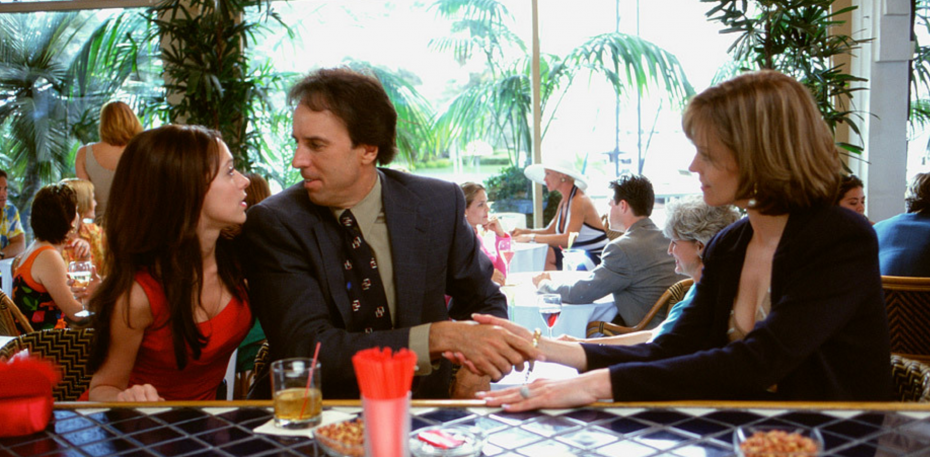
With Emma, we get a repeat performance; nightmares, BFF’s with Carmilla and then she comes down with the sickness.
A romantic interest is suspected between the two women when they run around Emma’s bedroom topless and collapse lovingly on the bed together.
My suspicions were confirmed later when Carmilla professes her love for Emma and that she doesn’t want anyone to take her away. If this doesn’t cinch it, at the forty-seven minute mark Carmilla strips down an entranced Emma and seductively kisses her naked body.
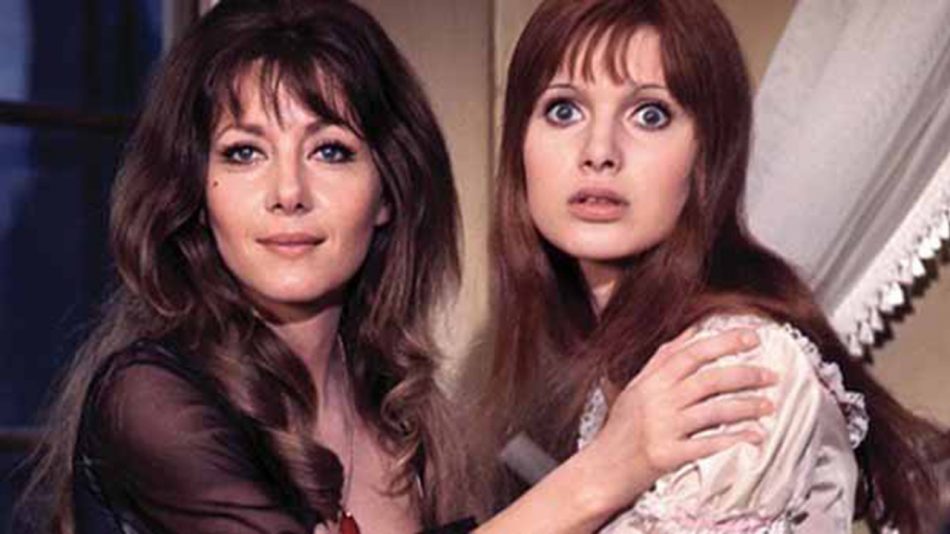
Next Carmilla strategically seduces the nanny, Madame Perrodot (Kate O’Mara), who was left in charge of Emma when her father went away. She wanted to prevent the doctor from checking on the ailing Emma.
The butler, Renton (Harvey Hall), throws a spanner in the works when takes the initiative and summons the doctor (Ferdy Mayne) despite the nanny’s objections.
The doctor discovers Emma is on the brink of death and places a cross around her neck and bombards her room with garlic flowers. Renton confirms vampires are at play when he offers the garlic flowers to Madame Perrodot (Kate O’Mara) and she runs like a scared child. Carmilla tries to visit Emma and backed off when she saw the vampire repellants in the room.
Carmilla was angry the doctor cock blocked her and we finally see fangs when she goes after him in the woods. She bumps off Renton next and then Madame Perrodot.
Carmilla tells Emma she is taking her home, which tells you that she really cares for Emma. In the end she wasn’t just killing for fun, she was protecting her love, not just a blood bag.
Carl (Jon Finch), a family friend, bursts in the house just in time to save Emma with a trusty cross and Carmilla vanishes into thin air.
Meanwhile, the General and Morton succeeded in their own mission and found the horribly aged Baron Hartog. They all return to the original castle and realize Carmilla is the vampire that got away when Hartog cleaned house the night he avenged his sister. Funnily enough, Carmilla appears at the castle and settles into her coffin.
The men know what they have to do and the General does the deed Van Helsing style. He stakes the vampire and then decapitates her. For someone’s first time, he seemed like a natural, almost like he had done it before in a land far away.
We see a little blood, but nothing graphic. The cool part was how the painting of Carmilla morphed and aged within seconds. Kind of like in The Horror of Dracula when Dracula basically burnt slash melted at the end. The strategy of using the cross at the end to disable the vampire was the same too.
Review
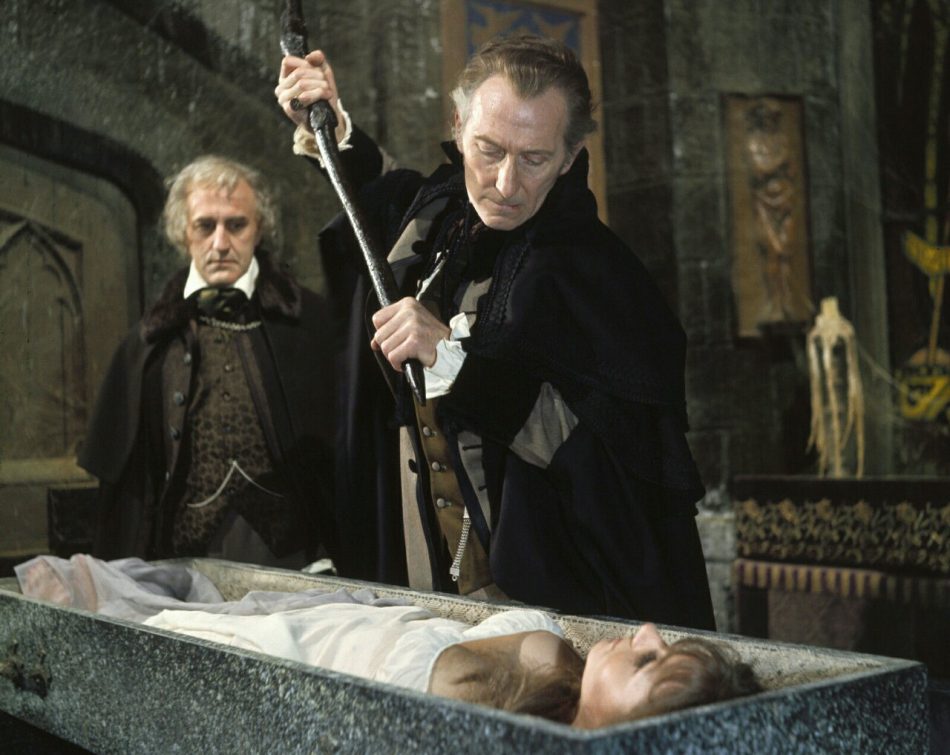
This film humanized the vampire and showed to what ends Carmilla was willing to go to for her love. Maybe she was taking Emma home to turn her and be together forever? I guess Laura was more of an infatuation than long term relationship material.
The angle of making the love interest two females, must have gone over well with the audiences back in the 1970s as they approached the hippy era of free love. There was a pattern of low cut dresses and flowing locks. I was totally surprised at amount of boob you saw. I don’t know about others, but when I was younger I didn’t romp around half naked with my female friends. Perhaps this was the norm for the era they were going for?
When Carmilla killed her victims I think they could have made things more realistic instead of her supposedly drinking them dry in seconds and dying instantly. Ideally there should have been way more blood and maybe some last words from her victims.
I found one aspect of the plot predictable; when they introduced the Countess and Marcilla so early on. The part I am still confused about is the vampire Mr. Bean. He just lurks in the shadows the whole time and laughs showing his fangs. Perhaps he was supervising and he assigned the two ladies the job of repopulating the castle? I am assuming they were his brides, but again I can’t confirm my speculations.
I think the sets in this film, as opposed the other Hammer Film I saw were more realistic. From the atmosphere in the castle and graveyard to the houses used. I found myself paying more attention to the actual storyline in this one as opposed to the ambiance. The female characters were ditzy, but amusing.
Overall, the movie was very entertaining. The quick storyline and cheesiness accompanied by the dramatic music were a winning combination. I am curious how many Hammer Films actually exist and I can see why fans flock to them. The film also makes me want to check out this Carmilla business as I have heard the name before related to either a books or plays. That will have to wait for another day.
The Vampire Lovers gets a virgin rating of four and a half stars ★★★★½
Notes:
- I instantly thought back to one of my previous reviews: Erin Chapman, “A Virgin’s View on ‘Horror of Dracula,'” Vamped, July 7, 2015, accessed June 29, 2016, http://vamped.org/2015/07/29/a-virgins-view-on-horror-of-dracula/.
I like your detailed description of the film, and the simplicity of the “virgin’s view”! It appears that you haven’t yet read “Carmilla,” the story by Joseph Sheridan Le Fanu, upon which this movie was based. It’s practically the only pre-Dracula story (it was published in 1872, a solid 25 years before Bram Stoker’s novel) that has been made into several movies or TV dramas. (A short film in Spanish was based very loosely on Polidori’s 1819 tale “The Vampire”; that’s the only other pre-Dracula story, to my knowledge, that was dramatized in a film.) I highly recommend “Carmilla”: in fact, in my opinion, it’s the greatest piece of vampire fiction ever written (and that’s saying a lot, because I’m not putting the others down!). It’s a very rich, deep story — almost every time I read it, I discover something new and interesting — and it raises a number of intriguing questions. Carmilla is not a “good vampire” by any means; however, she is not all bad, and in some ways may be a sorrowful or even pathetic character, so the amount of “evil” in her, versus the degree to which she deserves compassion, is one of the most fascinating questions. Also, does Carmilla really love the heroine in some way? (The heroine’s name is Laura in the story, although she’s the counterpart of the movie-character named Emma; the movie-character named Laura is named Bertha in the story.) And does the story condemn lesbian relationships, or merely treat them as a benign curiosity, condemning only vampirism? This last question gets particularly interesting when we compare the story to the movie, because I think the movie really does condemn lesbianism: Laura dies — at least in part — because she goes from the “right” relationship, with a young man, into the “wrong” relationship with the lesbian-vampire, whereas Emma is rescued because she goes from the “wrong” relationship into the “right” one. The young man Carl — who starts as Laura’s fiance, and then falls in love with Emma after he loses Laura — is the rescuer, or potential rescuer (he tries to rescue Laura near the beginning, but it’s too late), which seems to suggest that heterosexuality will rescue women if they turn to it in time. Also, like you, I am puzzled about the “vampiric Mr. Bean,” as you call him, or the Man in Black as the credits appear to name him (if I recall correctly). This character has no counterpart in the original story, “Carmilla,” and in the movie his presence seems to encourage the stronger patriarchal worldview of the film (in contrast to the story, which is less patriarchal). Female vampires, his presence implies, cannot do their work alone: they must be perpetually watched over, encouraged, and held accountable to the male vampire, who watches over them almost silently, without uttering an intelligible word; the only sound he makes is his laughter. Carmilla seems bound to report to him of her work in some ways, albeit silently; that’s the impression I get. Also, aside from the one scene near the beginning, when the Man in Black enters the ballroom and speaks with the Countess, we always see him on horseback, which adds to the authority of his position: he is literally “above” the female vampires, who are always on foot. (Incidentally, this male vampire must have an unusual horse to ride, because the doctor’s horse wants to flee in the presence of Carmilla, as horses usually do in Hammer films, when confronted with a vampire. Another interesting point is that Carmilla has a reflection — both in mirrors and in a pool of water — which makes her an unusual vampire in Hammer films. Maybe female vampires need reflections because they can’t do their makeup and dresses without them! That also adds a male chauvinist element, in my view.) So, comparing the movie to the original story is fascinating, just as analyzing each by itself is also fascinating. As you might have noticed, I’ve been coming from the point of view of a “feminist literary critic,” with some academic training, which is essentially what I am, although I probably belong to more schools of thought than just “feminism” by itself. This film is indeed entertaining, and I watch it repeatedly from time to time. I’m looking forward to your “virgin impression” of the story Carmilla — and I hope I haven’t given too much away, or spoiled the “virginity” of it! It’s really a great story, and I don’t think any film has yet fully done it justice.